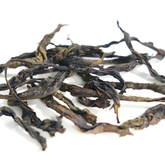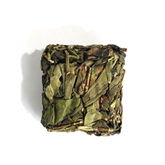Where Does Tea Come From? The History of Tea |NPTEA
"All tea plant DNA points to southwest China—this is the only origin of tea."
— Chen Zongmao, Academician of the Chinese Academy of Engineering and tea science expert Ten years ago, in the primeval forests of Lincang, Yunnan Province, China, I stood face-to-trunk with a jaw-dropping 18-meter-tall wild tea tree. Its trunk stretched over 10.7 feet wide (3.25 meters), and its age exceeded 3,200 years. A local Hani ethnic guide told me: "We call it the ‘Tea Ancestor’—our ancestors brewed its leaves for generations." In that moment, I felt I’d touched the very origin of tea itself.
Ten years ago, in the primeval forests of Lincang, Yunnan Province, China, I stood face-to-trunk with a jaw-dropping 18-meter-tall wild tea tree. Its trunk stretched over 10.7 feet wide (3.25 meters), and its age exceeded 3,200 years. A local Hani ethnic guide told me: "We call it the ‘Tea Ancestor’—our ancestors brewed its leaves for generations." In that moment, I felt I’d touched the very origin of tea itself.
The Origin of Tea
"All tea originates from a single plant in the mountain forests of southwest China—Camellia sinensis. This plant thrives in warm, humid climates (average annual temperature: 15-25°C/59-77°F), requires abundant rainfall, and grows best at higher elevations. Modern genetic sequencing confirms that all 380+ global tea varieties trace back to wild Camellia taliensis populations in Yunnan, China. Interestingly, many Western consumers mistakenly believe green tea, black tea, and oolong come from different plants. In reality, they all derive from the same tea plant—the differences in color and flavor arise from varying levels of fermentation during processing, which creates the six major tea types."
Interestingly, many Western consumers mistakenly believe green tea, black tea, and oolong come from different plants. In reality, they all derive from the same tea plant—the differences in color and flavor arise from varying levels of fermentation during processing, which creates the six major tea types."
The Discovery of Tea
The most widely told story about tea’s origin in China goes like this: Around 5,000 years ago, a legendary tribal leader named Shennong (the "Divine Farmer") tested various herbs daily in search of medicinal plants. One day, he accidentally ate a poisonous plant, collapsed, and chewed some nearby leaves in desperation—wild tea tree leaves. Miraculously, the leaves neutralized the toxin and saved his life. From then on, people recognized this miraculous plant’s detoxifying power. This story, recorded in The Divine Farmer’s Herb-Root Classic (Shennong Ben Cao Jing), China’s earliest surviving pharmacological text (compiled during the Han Dynasty, 1st-2nd century CE), marks tea’s legendary discovery.
This story, recorded in The Divine Farmer’s Herb-Root Classic (Shennong Ben Cao Jing), China’s earliest surviving pharmacological text (compiled during the Han Dynasty, 1st-2nd century CE), marks tea’s legendary discovery.
The History of Tea Use
The earliest use of tea dates back around 5000 BCE, when it was consumed as a medicinal herb. Roughly 2000 years later (by 3000 BCE), tea began to be cultivated intentionally and eaten as a vegetable—boiled in soups or seasoned as a dish.

A major shift came during China’s Tang Dynasty (618-907 CE), when people invented the "cake tea" method: steaming, compressing, and boiling tea cakes. This era also marked the birth of Japanese and Korean tea ceremony traditions, influenced by Tang practices.The modern habit of steeping loose-leaf tea emerged much later, during China’s Ming and Qing dynasties (1368-1912 CE), when teapots and individual cups became widespread.
| Stage | Time Period | Primary Use | Key Highlights (Impact) |
|---|---|---|---|
| Medicinal Use | Shennong Era (~2800 BC) | Detoxification remedy | Earliest records in ancient texts laid the foundation for tea’s medicinal reputation in China. |
| Food & Drink Use | Western Zhou to Song Dynasty (1000 BC – 1279 AD) | Royal tribute, food ingredient, and boiled/drip tea beverage | Evolved from an elite luxury to a daily drink; inspired tea rituals and cultural exports (e.g., spread to Japan). |
| Ming-Qing Era | Ming to Qing Dynasty (1368–1912) | Brewed beverage & global trade item | Loose-leaf tea replaced compressed cakes, simplifying preparation. China dominated global tea trade (exported to Europe/America). |
| Modern Era | 1846–Present | Mass-produced commodity | Mechanized production boosted efficiency; China regained its status as a top tea producer. |
The Invention History of China’s Six Major Tea Types
China’s six major tea types evolved over centuries through happy accidents in tea-making. Green tea came first, perfected during the Tang Dynasty (7th-10th centuries) with simple drying methods. Yellow tea was discovered by chance when green tea leaves were left steamed too long, turning golden.
By the Ming Dynasty (14th-17th centuries), dark tea emerged unintentionally during long-distance trade—natural fermentation happened to tea stored on caravans.
The Qing Dynasty (17th-20th centuries) brought two breakthroughs: oolong tea and black tea. Fujian farmers created oolong by shaking leaves to trigger partial fermentation. Later, Wuyi Mountain tea-makers hiding from war accidentally used firewood to dry tea leaves, sparking full fermentation—and black tea was born.
This journey shows how Chinese tea evolved from simple green leaves to masterful fermented brews through curiosity and serendipity!
| Tea Type | Origin Period | Fermentation Level | Iconic Teas |
|---|---|---|---|
| Green Tea | Zhou Dynasty (around 1000 BCE) | Non-fermented (0%) | Longjing (Dragon Well), Biluochun, Sencha (Japan) |
| White Tea | Ming Dynasty (after 1368 CE) | Light oxidation (5-10%) | Baihao Yinzhen (Silver Needle), Baimudan (White Peony) |
| Yellow Tea | Tang Dynasty (speculated) | Mild oxidation (10-20%) | Junshan Yinzhen (Yellow Bud), Mengding Huangya |
| Oolong Tea | Late Ming to Early Qing Dynasty (~1600 CE) | Semi-oxidized (20-70%) | Tieguanyin (Iron Goddess), Da Hong Pao (Big Red Robe), |
| Black Tea | Late Ming Dynasty (~1610 CE) | Fully oxidized (80-95%) | Zhengshan Xiaozhong (Lapsang Souchong), Keemun, Assam (India),Dianhong |
| Dark Tea | Ming Dynasty (after 1368 CE) | Post-fermented (microbial aging) | Pu-erh Tea (Yunnan), Anhua Dark Tea (Hunan), Tibetan Yak Butter Tea (Sichuan) |
The Global History of Tea Trade
Tea started as China’s exclusive "luxury item"—even most Chinese people rarely drank it. By the 17th century, Europeans became obsessed with Chinese tea. Upper-class societies adopted afternoon tea culture, and Dutch East India Company ships began hauling Chinese tea to Europe and America. British traders even swapped opium for Fujian’s black tea, and the Boston Tea Party famously helped spark the American Revolution. China closely guarded its tea-making secrets until the 1840s, when British botanist Robert Fortune disguised himself, snuck into Anhui province Chian, and stole tea plant seeds + skilled workers. These were used to build colonial tea farms in Assam (India) and Sri Lanka, breaking China’s monopoly. Machines using the CTC (Crush-Tear-Curl) method soon flooded global markets with Indian Darjeeling and Ceylon teas.
China closely guarded its tea-making secrets until the 1840s, when British botanist Robert Fortune disguised himself, snuck into Anhui province Chian, and stole tea plant seeds + skilled workers. These were used to build colonial tea farms in Assam (India) and Sri Lanka, breaking China’s monopoly. Machines using the CTC (Crush-Tear-Curl) method soon flooded global markets with Indian Darjeeling and Ceylon teas. Today, 2 out of every 3 cups of tea you drink use leaves grown in India or Africa. But the world’s finest teas—like those from Fujian’s Wuyi Mountains or Yunnan’s ancient tea forests—are still made in China. These premium teas are so scarce they barely meet local demand, let alone reach international shelves.
Today, 2 out of every 3 cups of tea you drink use leaves grown in India or Africa. But the world’s finest teas—like those from Fujian’s Wuyi Mountains or Yunnan’s ancient tea forests—are still made in China. These premium teas are so scarce they barely meet local demand, let alone reach international shelves.
The Rise and Fall of China’s Tea Empire
From 1840 to 1886, China’s tea industry enjoyed its Golden Age. Production exploded from 50,000 to 250,000 tons, with black and green tea making up over 90% of global exports. Prices were so steep that the British complained that "every sip was like drinking silver."
But everything collapsed after 1886. Britain began growing tea in its Indian and Sri Lankan colonies, using mechanized production to flood markets with low-cost black tea. China’s tea export prices plummeted by 50%, and by 1900, exports crashed to 80,000 tons. Vast tea fields turned to wasteland.
This "Tea War" reshaped the world: China fell from global tea ruler to a mere raw material supplier, while Indian black tea conquered Western teacups.
| Country | Share of Global Production | Main Growing Regions | Fun Facts & Flavors |
|---|---|---|---|
| China | ~45% | Fujian, Yunnan, Zhejiang | Birthplace of tea! Famous for oolong's floral twists, pu'erh's earthy funk, and jasmine-scented greens. |
| India | ~20% | Assam, Darjeeling, Nilgiri | Land of chai! Assam teas pack a malty punch, Darjeeling offers "champagne of teas" with muscat notes. |
| Kenya | ~10% | Central Highlands | Africa's tea king! Bold black teas (perfect for tea bags) with a brisk, bright kick. |
| Sri Lanka | ~5% | Central Province | Former "Ceylon" teas! Zesty lemon/citrus vibes, ideal for iced tea and tropical blends. |
| Japan | ~2% | Shizuoka, Kagoshima | Matcha madness! Vibrant powdered greens, toasty hojicha, and seaweed-like sencha. |
| Vietnam | ~4% | Northern Highlands | Rising star! Creamy jasmine teas, buttery oolongs, and budget-friendly black teas. |
Global tea production now exceeds 7 million tons annually. While China still produces over 40%, India, Kenya, and Sri Lanka are major players. Machine production has made tea bags cheap and convenient (think $3 a box at supermarkets), while traditional handcrafted teas—like Dian Hong or Pu’er—can sell for $500+ per pound, becoming luxury collectibles for those chasing the ultimate brew.
SEE MORE ABOUT CHINESE TEAS
If you have questions about selecting tea:
Learn-more-about-chinese-tea
If you have questions about the benefits of tea:
Health-benefits-of-chinese-tea
If you have questions about brewing tea:
How-to-brew-loose-leaf-tea






